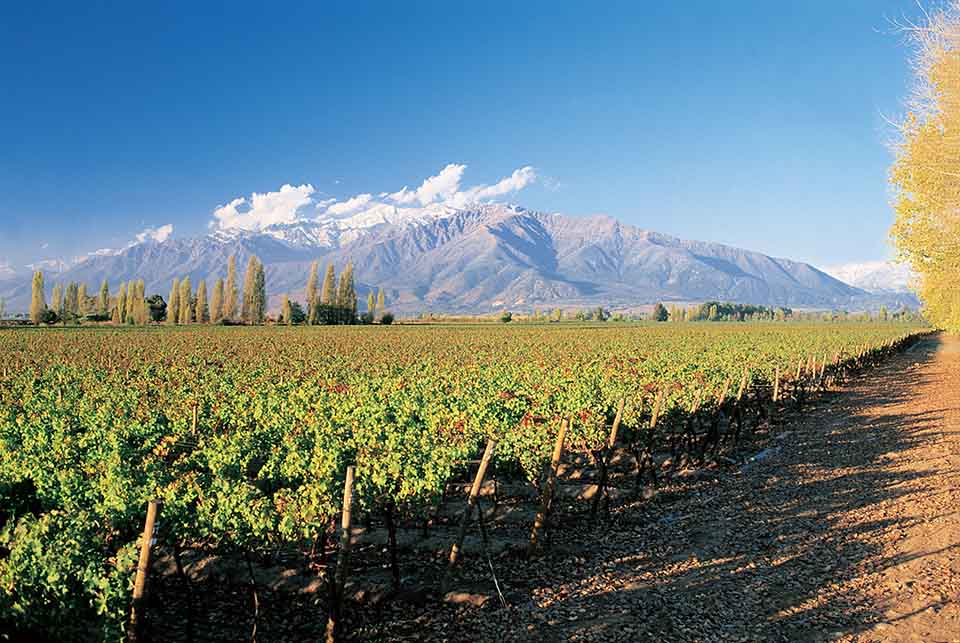
If grapes were intelligent creatures that could speak, some of them would have an interesting story to tell. Take Carménère for example. Like most ancient grapes, no one is absolutely certain where it originated, though it probably came from the Bordeaux region of France many hundreds of years ago. DNA analysis has revealed that Carménère (KAH-may-nair) is one of four varieties that all have the same “parent”, in this case Cabernet Franc. The other three (since you asked) are Merlot, Cabernet Sauvignon and the somewhat obscure Hondarribi Beltza which is found only in the Basque region of Spain. This is why Carménère has a similar taste profile to both Merlot and Cabernet Franc.
But you’d be hard-pressed to find it in France these days. The phylloxera plague of 1867 destroyed nearly all of Europe’s vineyards, afflicting the French Carménère grapevines in particular. When the vineyards were eventually replanted, Carménère rather missed out because it was tricky to grow in the cool conditions of Bordeaux. The result was that Bordeaux vineyards were replanted with more hardy varieties such a Merlot and Cabernet Sauvignon. Poor old Carménère, considered one of the six original grapes of Bordeaux was presumed extinct.
But the story of Carménère was not over. Not by a long way. Sometime during the 1850s Carménère cuttings were taken to Chile. At the time, Chilean wineries were modelled on those of Bordeaux and the new vines thrived in the warm, sunny climate, minimal rainfall and near-perfect environment. They had found a welcoming new home. Unfortunately, everyone (including the growers and wine-makers) assumed that the grape was a type of Merlot. During most of the 20th century, Carménère grapes were usually processed together Merlot grapes giving Chilean Merlot a distinctive taste profile and notably different from those produced elsewhere.
It was not until 1994 that extensive research by the French ampelographer Jean-Michel Boursiquot revealed the amazing truth, later confirmed by DNA analysis. It was not Merlot after all, but the long-forgotten Carménère.
So what does it taste like? Well, Carménère is usually a medium to full-bodied dry red wine and the top-quality examples bring aromas of tobacco, leather, dark fruit, coffee, bell pepper, and chocolate. There are often spicy flavours of peppercorn. Carménère is currently poised to pass Merlot and become Chile’s second most widely planted red variety after Cabernet Sauvignon.
In Spanish, bodega in this context means a wine estate. And yes, the second word really does mean volcanoes, for this is an example of the so-called “volcanic wines” which are quite rare, but produced in relatively small quantities in Italy, Spain and Greece. Those from Mount Etna are among the best-known. These wines are made from grapes grown in soil which contains the remnants from past volcanic eruptions: basalt rock, ash and pumice on which vines thrive. Because volcanic ash is porous, the vine roots absorb water which contains additional nutrients such as magnesium, calcium, sodium, iron and potassium. Because the land is invariably rugged, the grapes must be harvested by hand.
In Chile, the word Reserva indicates that the wine is at least 12% ABV. Chilean wine law requires that that the grape variety, vintage, and geographical area shown on the label must make up 75 percent of what’s in the bottle. The remainder can come from anywhere else, but most Chilean wine contains at least 85 percent, so that the product remains legal for distribution in Europe.
Unusually, this bottle is sealed with a cork rather than the conventional screw-top, so you’ll need to ferret out your corkscrew. And I hope it’s a strong one, ideally with two levers. The simple T-shaped model probably wouldn’t stand a chance with this bottle unless you have hands like a gorilla.
The wine is an opaque dark red with a distinct violet hue. The aromas really blossom after the bottle has been open about half an hour. I’d suggest that you aerate the wine by pouring it into a decanter. Alternatively, just allow the wine to rest in the glasses for about ten minutes. Not only will this give the wine a chance to breathe, it will also test your ability to resist temptation. You’ll probably notice the signature aromas of rich red berry fruit and plums along with a spicy tang of white pepper. You might even pick up a hint of green capsicum too. At 13.5% ABV, it’s a notably dry wine and although medium-bodied, it has a compelling assertiveness and rich in firm tannins yet with a remarkably smooth and velvety texture.
There’s a splendid balance of fruit and tannin and a long satisfying finish, but be sure to slosh the wine around in your mouth to get the full taste experience. In the French style, the makers have gone easy on the fruit to produce a firm, authoritative wine that would go splendidly with beef or other rich meat dishes. Some wine writers believe that Carménère pairs exceptionally well with roast pork and lamb or any lean grilled meats. It would work even with turkey and duck. This is an excellent example of a mid-range Chilean Carménère and if you’ve never tasted Carménère or volcanic wine before, do give this one a try.
 |
 |
 |





